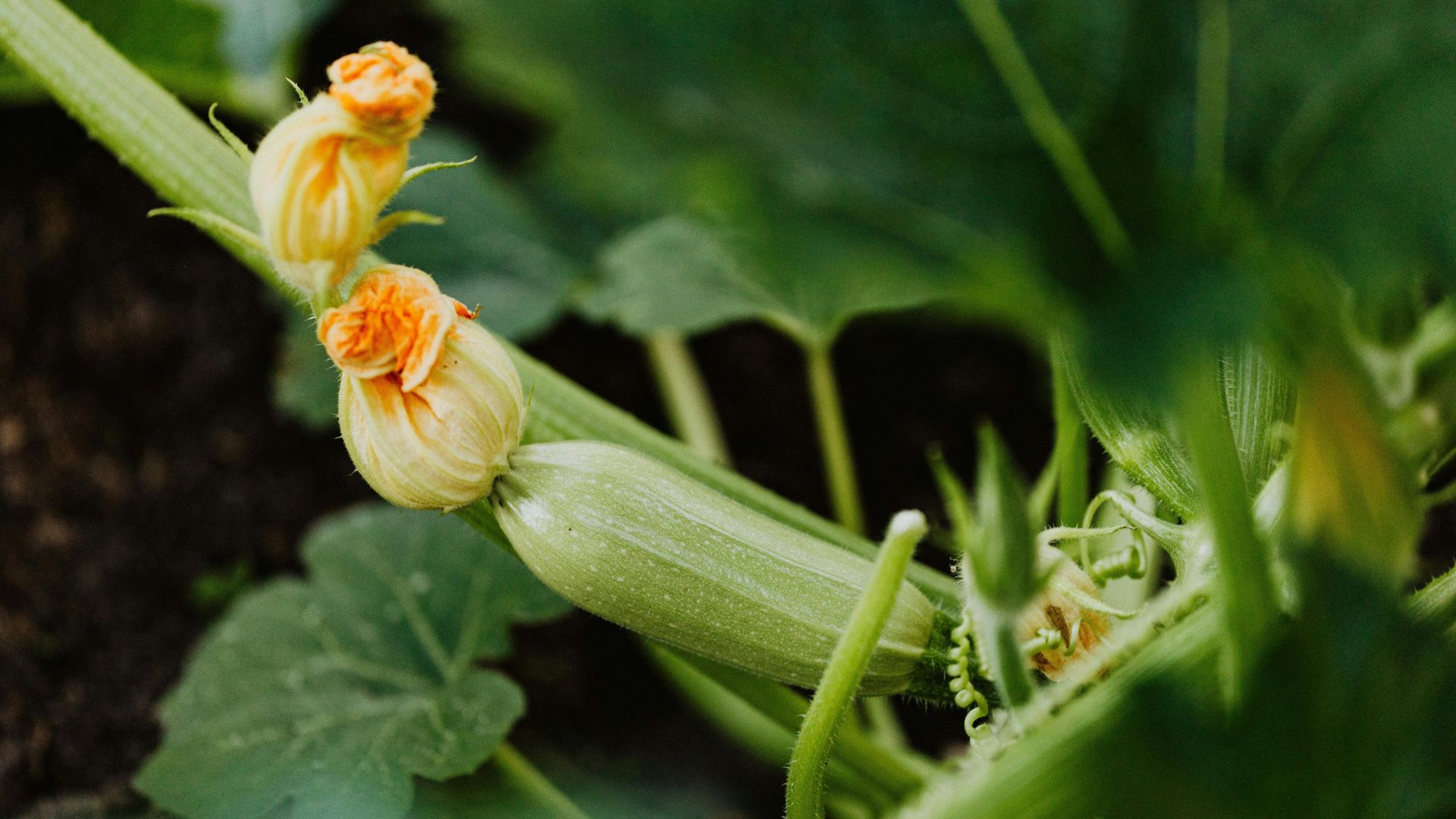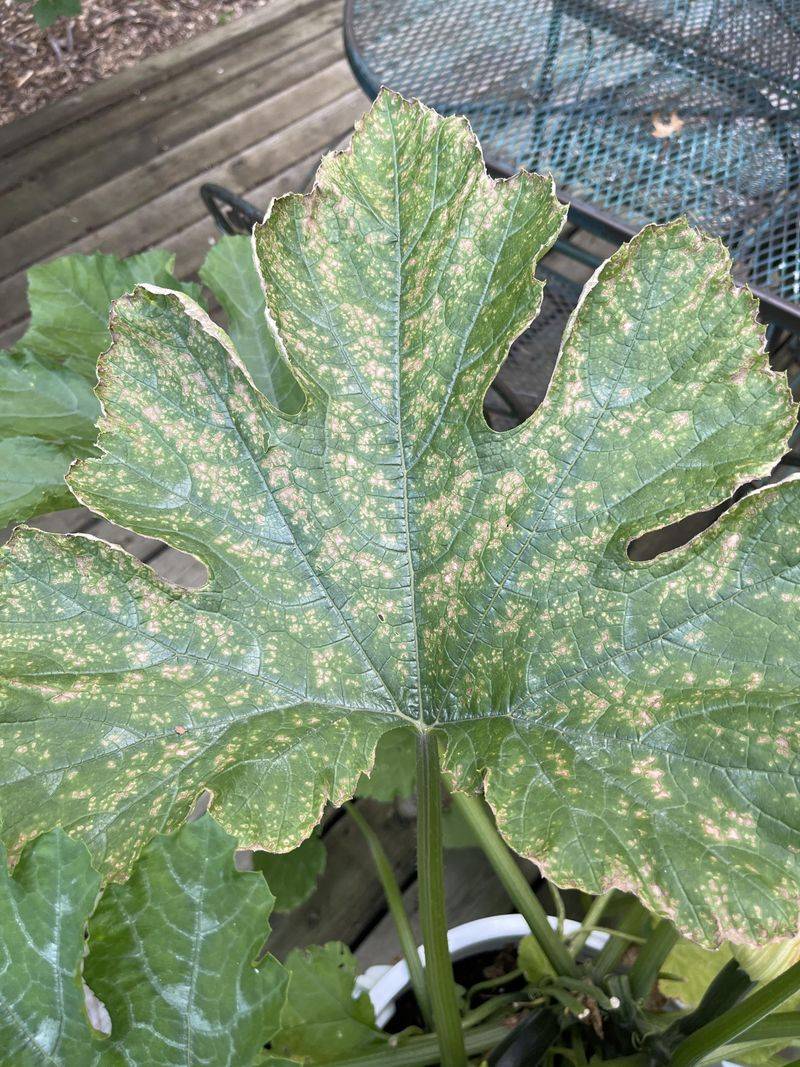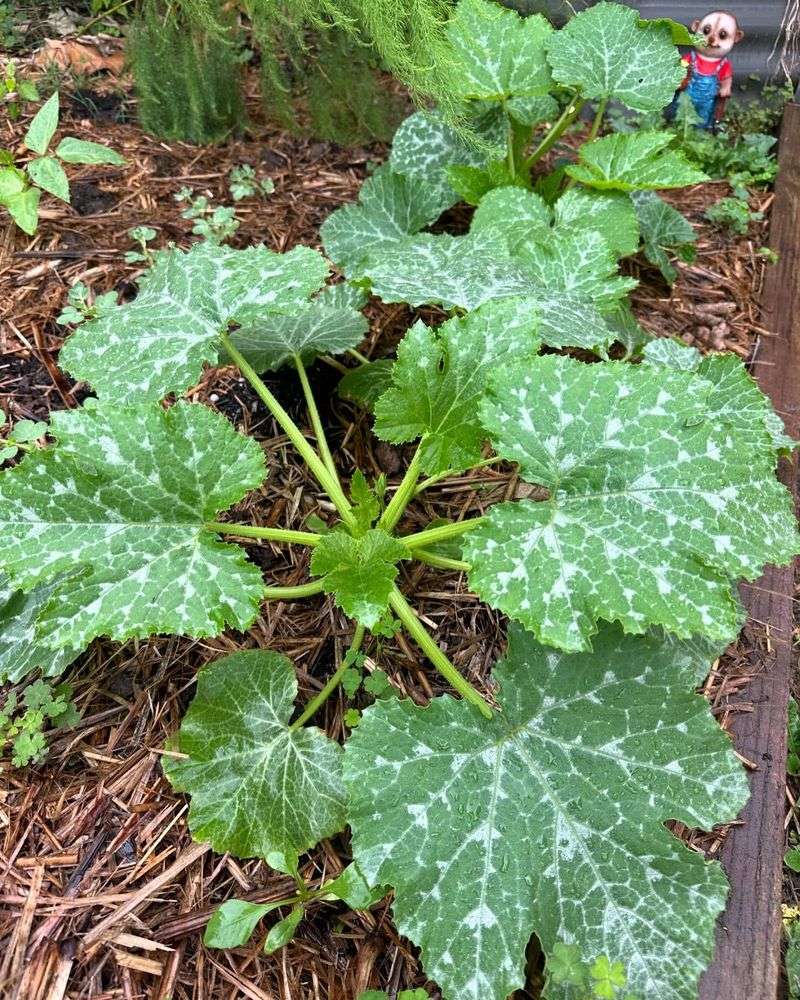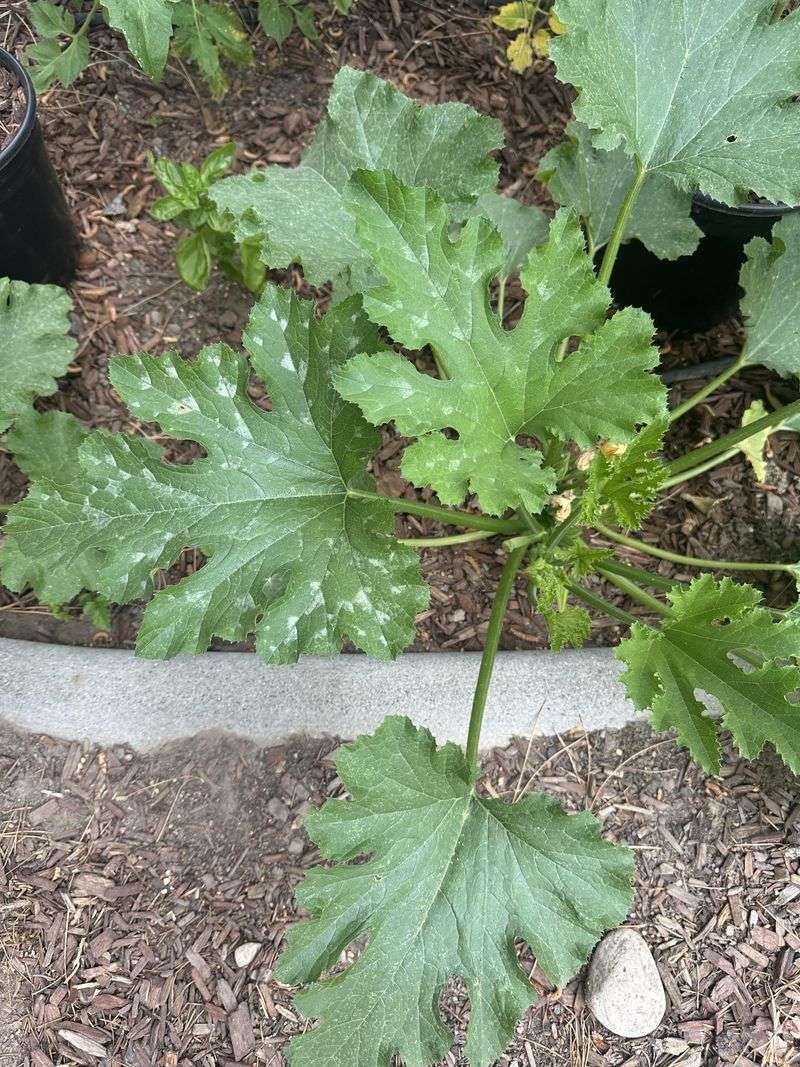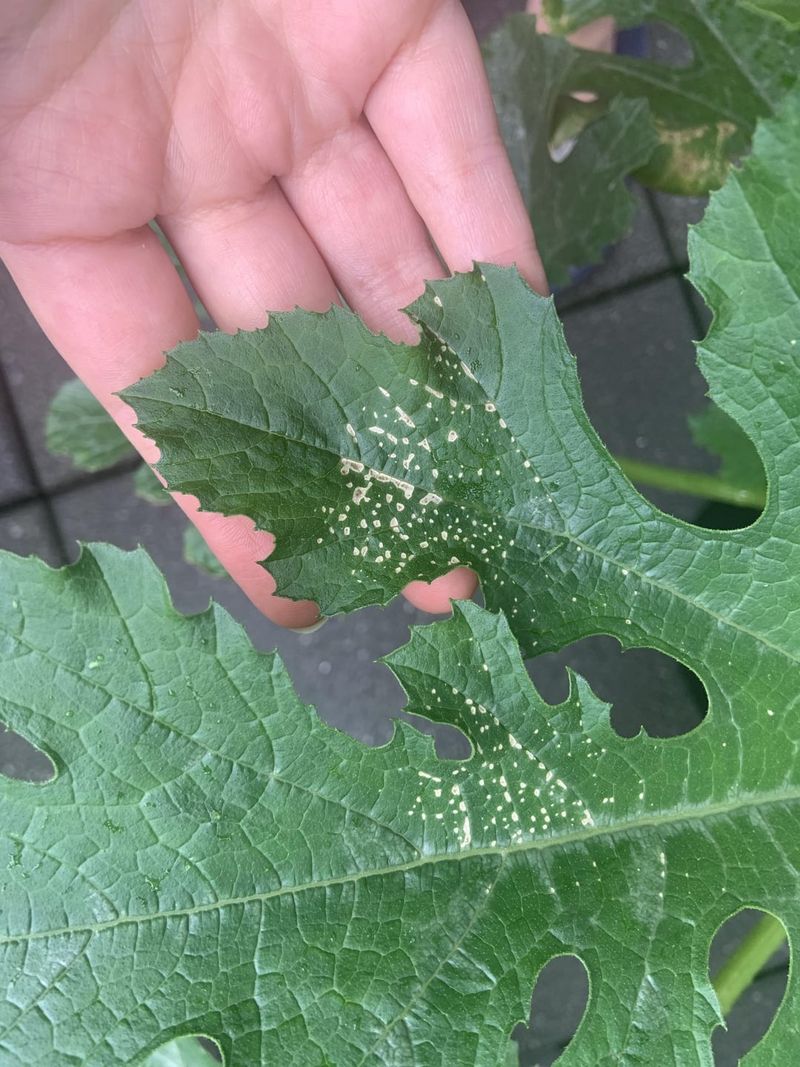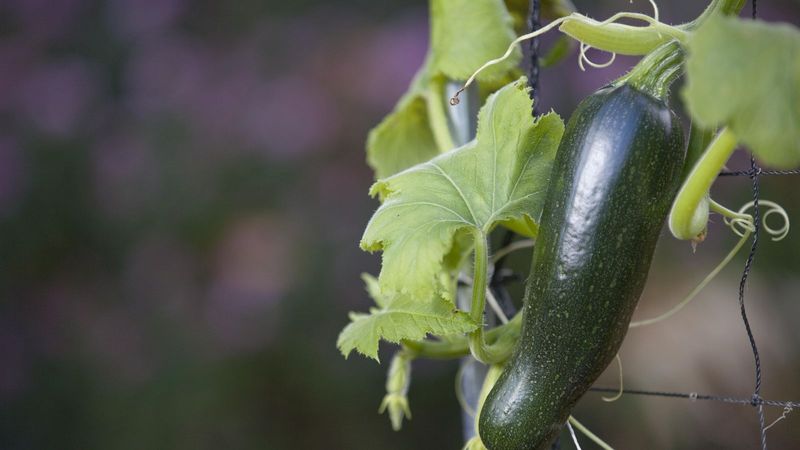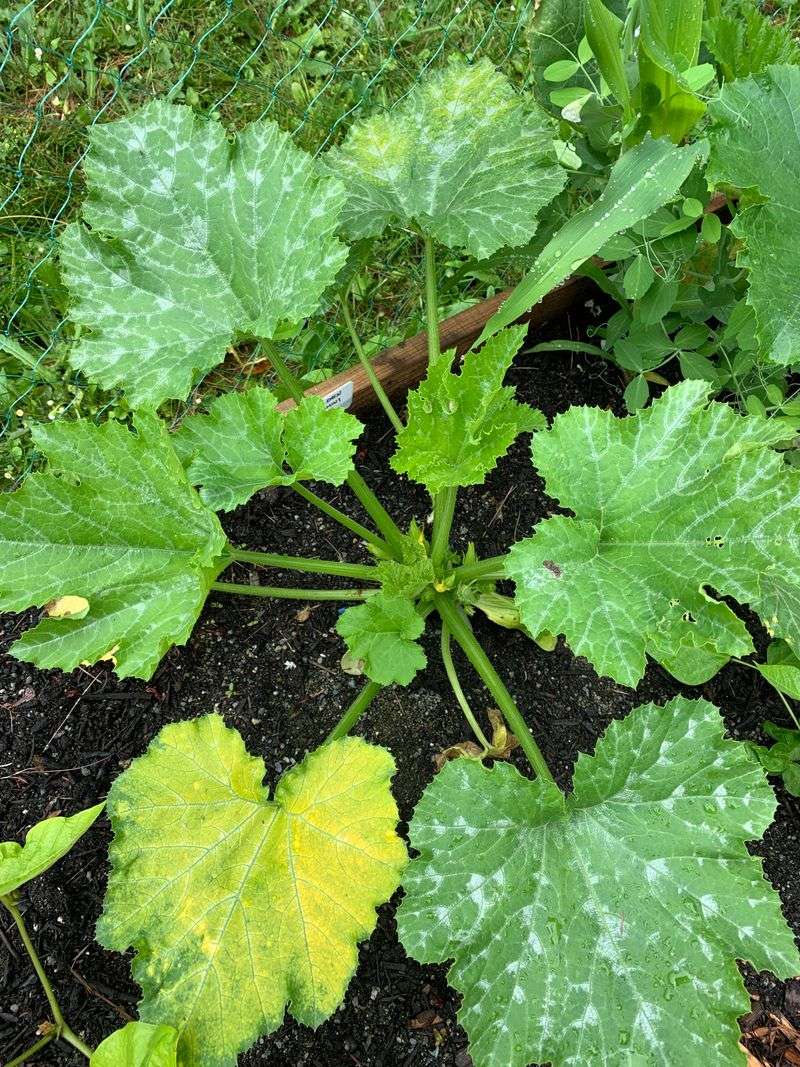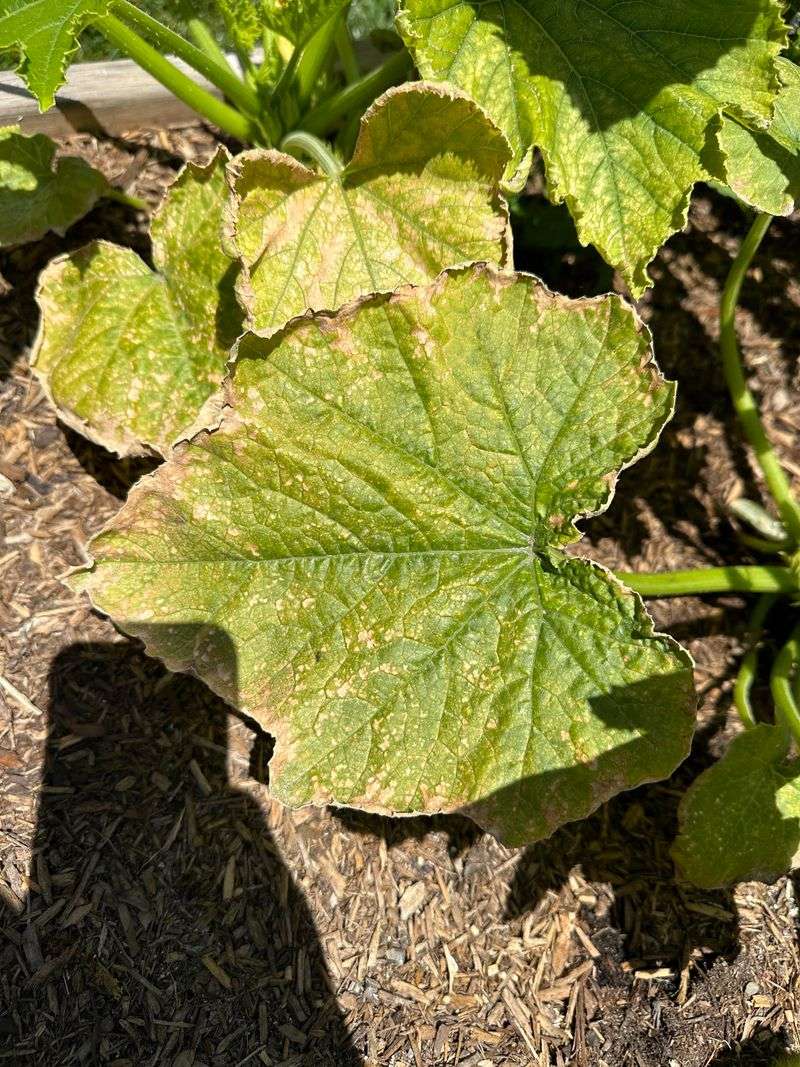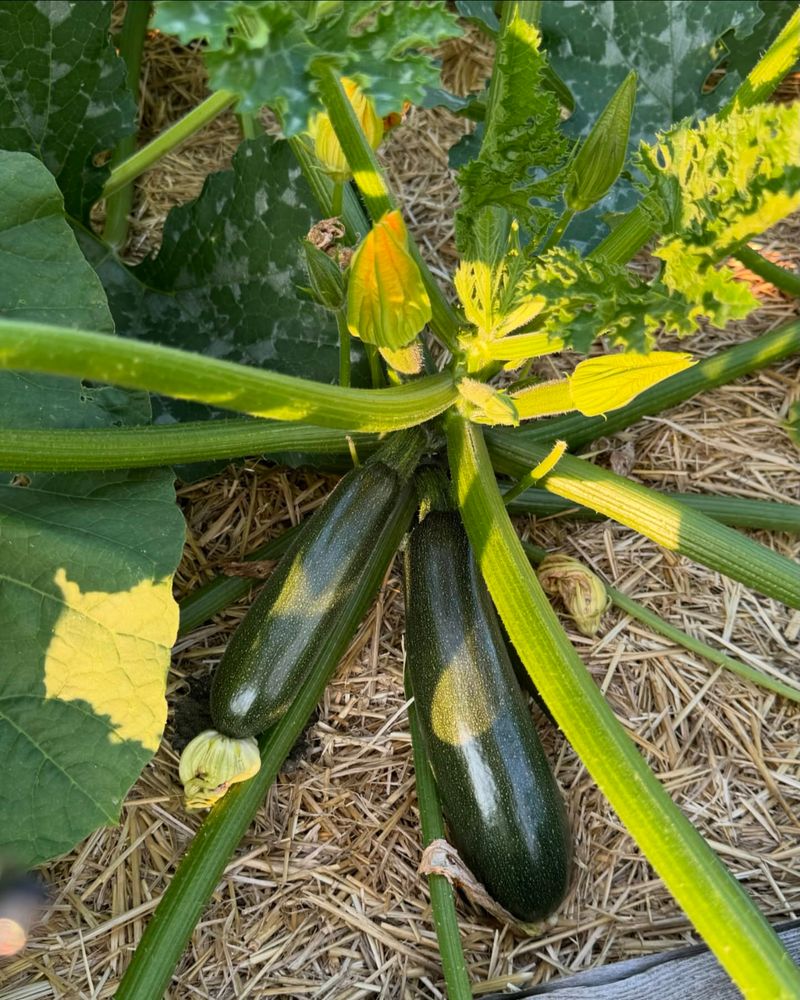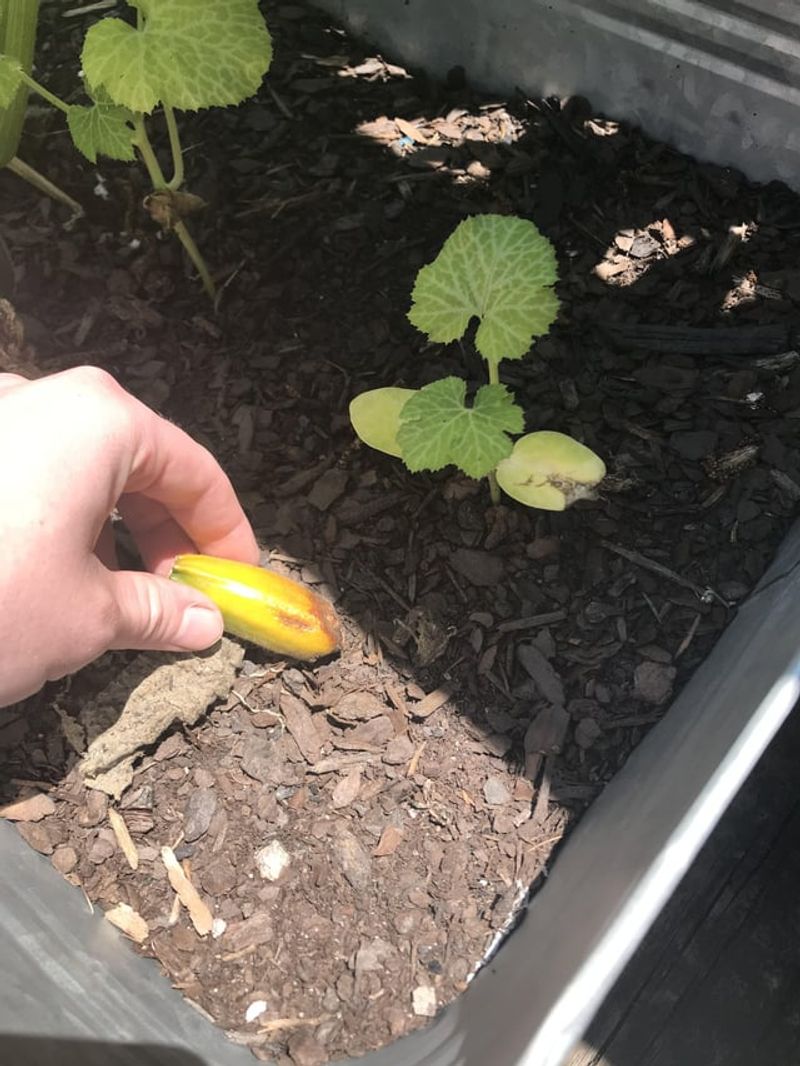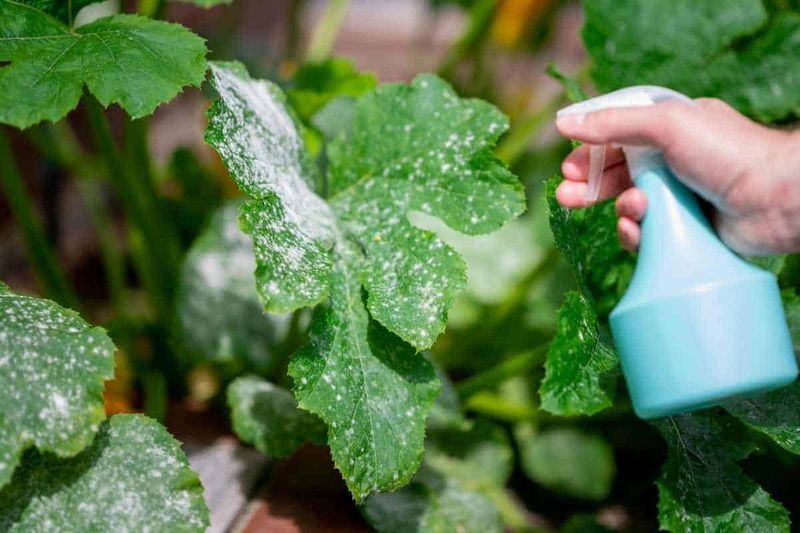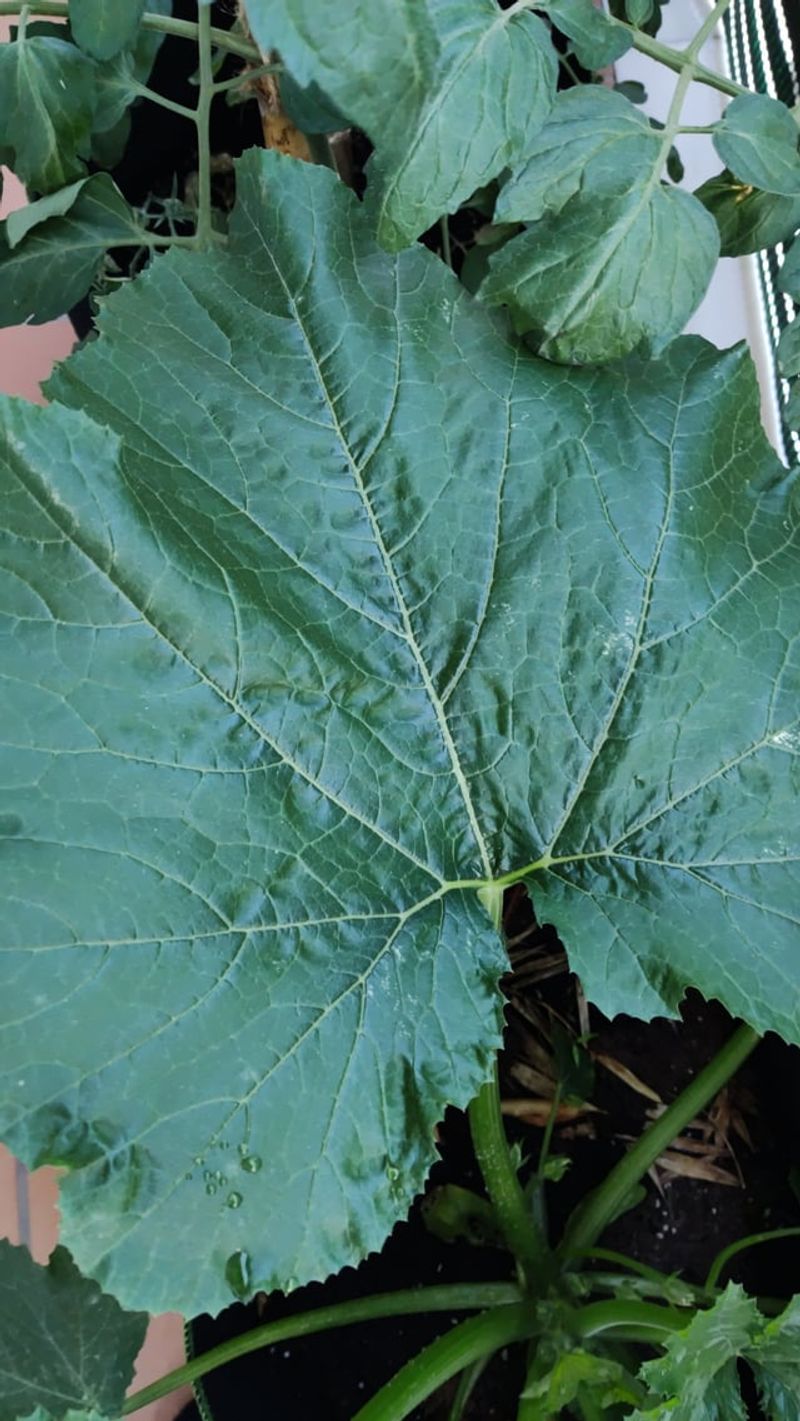Gardeners across California are spotting something strange—zucchini leaves covered in white patches, stretching from San Diego all the way up to Sacramento. I noticed it in my own yard just yesterday, and soon realized my neighbors were seeing it too.
Between our unpredictable weather lately and the usual summer stressors, conditions have tipped in favor of a few common culprits. Powdery mildew is one likely suspect, but heat stress and sunscald can play a role too.
It’s a good reminder that even familiar plants need extra care when climate swings hit. Keeping airflow strong, watering at the base, and removing affected leaves can help bring your zucchinis back to full health.
1. Powdery Mildew Outbreak
The coastal fog rolling in earlier than usual this week has created perfect conditions for powdery mildew to spread rapidly. This fungal disease looks like someone dusted your plants with flour.
In my garden near Monterey, it always starts on the older leaves first. A simple mixture of 1 tablespoon baking soda in a gallon of water with a few drops of dish soap can help manage small outbreaks.
Make sure to apply early morning so leaves dry completely during the day. Removing the worst affected leaves can prevent it from spreading to healthy parts of your plants.
2. Sunscald From Heat Wave
Last week’s sudden temperature spike caught many plants off guard. When temperatures jump above 95°F, zucchini leaves can develop white or bleached areas where the intense sun literally burns the leaf tissue.
Unlike disease patterns, sunscald typically appears on the uppermost leaves that get the most direct light. I’ve noticed this happening more in my inland garden where afternoon shade is scarce.
Temporary shade cloth (30-40%) during the hottest part of the day can save your plants while they adjust to the heat. Water deeply in early mornings to help plants cope.
3. Hard Water Mineral Deposits
Many California regions have hard water, and this week’s increased irrigation needs have left mineral deposits on leaves. After water evaporates, calcium and magnesium leave behind a white residue that blocks sunlight.
Try examining the white areas with a magnifying glass – mineral deposits will wipe off, unlike mildew which is embedded in the leaf. My Sacramento garden struggles with this every summer when I increase watering.
Switching to drip irrigation keeps water off leaves entirely. For existing deposits, a light spray of diluted vinegar (1 part to 10 parts water) can dissolve minerals without harming plants.
4. Whitefly Infestation
The recent warm spell has triggered whitefly populations to explode across California gardens. These tiny white insects cluster underneath leaves, sucking sap and leaving a sticky residue that turns white as it dries.
Flip over affected leaves and you’ll likely see the culprits scatter when disturbed. Yellow sticky traps have saved my San Diego zucchini patch many times from these pests.
A strong blast of water under leaves can dislodge many of them. For organic control, introduce ladybugs in the evening when they’re less likely to fly away before finding the whiteflies.
5. Drought Stress Symptoms
Despite recent irrigation, California’s ongoing drought conditions are showing up as white streaking on zucchini leaves. Plants struggling with insufficient water often develop pale striping along leaf veins.
The soil in my raised beds dries out faster than expected during hot weeks like this one. Mulching with a 2-inch layer of compost or straw helps retain crucial moisture around zucchini roots.
Deep watering twice weekly is better than daily light sprinkling. The whitening should reverse within days of correcting water issues, with new growth showing normal coloration.
6. Spider Mite Damage
Spider mites thrive in hot, dry conditions – exactly what we’ve had this week. These nearly microscopic pests cause a distinctive white stippling on leaves as they extract chlorophyll from individual cells.
Hold a sheet of white paper under affected leaves and tap – tiny moving dots indicate spider mites. I’ve found that regular misting of plants discourages these pests since they prefer dry environments.
Neem oil applications at dusk (when beneficial insects are less active) can help control infestations. Severe cases might require removing the worst affected leaves to prevent spread to the rest of the plant.
7. Chemical Spray Residue
Many gardeners have increased their defensive spraying during this challenging growing week. Commercial fungicides, insecticides, or even homemade solutions can leave white residue on leaves after drying.
Check your recent garden activities – did you apply any treatments in the past 7 days? I accidentally over-concentrated my milk spray (a powdery mildew remedy) last month and created similar white patches.
A gentle rinse with clean water in the early morning can remove most residues without promoting fungal issues. Always follow product dilution instructions precisely to avoid leaf damage or unsightly residue.
8. Downy Mildew Infection
Often confused with its cousin powdery mildew, downy mildew creates white-yellow patches on leaf tops with grayish-purple fuzzy growth underneath. This week’s unusual combination of warm days and foggy mornings has created perfect conditions.
Look at the underside of affected leaves for the telltale purple-gray fuzz. In my coastal garden, this always appears after a few days of morning fog followed by warm afternoons. Improve air circulation by pruning crowded plants and watering at soil level only.
Copper-based fungicides work well if applied at the very first sign of infection, before it spreads throughout your zucchini patch.
9. Fertilizer Salt Buildup
Many gardeners have recently applied summer fertilizer boosts, not realizing that excess salts can accumulate in soil and on leaves. The white crusty deposits appear along leaf edges first, progressing inward as salt concentration increases.
California’s low rainfall means salts don’t get naturally flushed from soil. When I noticed this in my Fresno garden, I immediately leached the soil with extra water to flush excess nutrients.
Apply fertilizers at half the recommended strength but twice as often for zucchini plants in our climate. This prevents salt buildup while still providing necessary nutrients for heavy-feeding squash plants.
10. Leaf Miners Creating Trails
Leaf miners have been particularly active this week, leaving distinctive white tunnels or trails as they eat through the inner leaf tissue. These tiny larvae live between the upper and lower surfaces of the leaf.
Hold affected leaves up to sunlight to see the silhouettes of the tiny insects inside the trails. When I found these in my garden last summer, I started checking new growth daily to catch problems early.
Remove and destroy (don’t compost) affected leaves to prevent miners from completing their lifecycle. Yellow sticky traps help catch the adult flies before they lay eggs on new leaves.
11. Pesticide Drift From Neighbors
Urban and suburban California gardeners might be experiencing white leaf spots from pesticide drift. Many homeowners have increased pest control measures this week due to summer insect activity.
The pattern appears randomly across plants, often worse on the side facing neighboring properties. I’ve had this happen in my community garden plot when the property next door was sprayed on a windy day.
Politely discuss the issue with neighbors or install a temporary barrier during spray days. Growing a hedge or tall border plants can provide long-term protection from drift while maintaining good neighborly relations.
12. Boron Deficiency Symptoms
California’s alkaline soils often bind up boron, making it unavailable to plants. The recent heat has accelerated growth, increasing micronutrient demands and revealing deficiencies as white mottling between leaf veins.
Young leaves curl upward and developing fruit often shows brown spots or cracks. My garden in the Central Valley frequently shows these symptoms by mid-summer when plants are producing heavily.
A foliar spray of 1 tablespoon borax dissolved in 1 gallon of water can provide quick relief. Apply to a few leaves first as a test – too much boron can be toxic to plants.
13. Bacterial Leaf Spot Outbreak
Recent thunderstorms in parts of California created perfect conditions for bacterial leaf spot to emerge. This infection causes white-to-tan spots with yellow halos that eventually turn brown and crispy.
Unlike fungal issues, bacterial problems worsen after rain or overhead watering. The bacteria splashes from soil onto leaves during watering. My plants in the Bay Area always show this after unusual summer rain.
Avoid working with plants when wet to prevent spreading bacteria. Remove infected leaves and apply a copper-based bactericide if the problem is widespread. Mulching prevents soil splash during irrigation.
14. Cold Night Temperature Shock
This week’s unusual temperature fluctuations have shocked many plants. Several regions experienced daytime highs near 90°F followed by nighttime dips below 55°F, causing stress whitening on zucchini leaves.
The whitening typically appears overnight and affects newest growth first. I’ve observed this phenomenon in my foothill garden where evening temperatures drop dramatically after sunset.
Row covers or water-filled containers near plants can moderate nighttime temperatures. Plants usually recover without intervention once temperatures stabilize, though growth may slow temporarily while they adjust to the fluctuations.
15. Ozone Damage From Air Pollution
California’s recent air quality issues have increased ground-level ozone, which damages plant tissue and creates white stippling or bleaching on upper leaf surfaces. Urban and suburban gardens are most affected, especially during hot, still days.
The damage pattern shows as tiny white flecks that eventually merge into larger patches. My Los Angeles garden shows this every summer when smog levels rise during heat waves. Unfortunately, there’s no direct treatment for ozone damage.
Focus on keeping plants healthy with proper water and nutrients to help them tolerate the stress. Consider growing more ozone-resistant varieties next season if this is a recurring problem.

